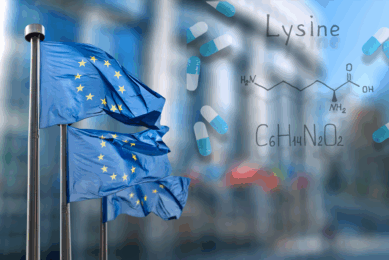Reducing the anti-nutrient effect of phytate

Phytate can reduce the solubility of up to half of the protein in conventional diets, resulting in a physiological cascade which adversely influences the nutritional value of energy and amino acids. Exogenous phytase can counter these effects, improving amino acid and energy digestibility.
Phytase is an enzyme that can break down the poorly digestible phytate salts found in grains and oil seeds, releasing digestible phosphorus and calcium. Besides being a digestible phosphorus diulent, phytate is also an aggressive antinutrient having the capacity to influence secretion and absorption dynamics in the gastro-intestinal tract (Ravindran et al., 1999).
Cowiesonet al. (2004) demonstrated that the ingestion of phytic acid can negatively influence amino acid, energy and mineral excretion by broilers (Figure 1) and this has been subsequently confirmed using a peptide alimentation method (Figure 2; Cowieson & Ravindran, 2007a). The mechanisms by which phytate (and axiomatically therefore phytase) alter secretory and absorptive physiology are not fully understood but are thought to be related to the reactive nature of phytate and electrostatic aggregation of dietary protein in the gastric phase of digestion.
Protein binding
In dietary ingredients phytate exists as a salt of K and Mg and is relatively unreactive (Lottet al., 2000). However, when feed is exposed to the low pH conditions in the proximal gut, phytate becomes soluble as H+ ions replace K and Mg (Cosgrove, 1966).
At this low pH many proteins are below their isoelectric point and thus become positively charged.
Those phosphates in the phytate molecule with the lowest pKa are still negatively charged and thus bond electrostatically to these proteins. In a second, slower phase these complexes precipitate as they interact with other proteins until solubility is lost. Stochiometrically it is suggested that 1 g of phytate can bind 10 g of protein under ideal conditions.
Consequently, up to half of the dietary protein in a typical broiler diet may be negatively influenced by de novo phytate:protein complex formation.
However, the extent of this reaction depends on the concentration and solubility of phytate, dietary Ca concentration, ambient pH, the isoelectric point of the protein, and also its tertiary and quaternary structure (i.e. the degree of steric hindrance between reactive amino acids and phytate).
These phytate-protein complexes are variably refractory to digestion by pepsin and solubilisation with HCl (Vaintrub & Bulmaga, 1991), leading to an increase in the secretion of these by the animal. On gastric emptying, the distal gut is faced with a luminal challenge to maintain favourable conditions for optimal functioning of the pancreatic and brush border enzyme array, and for a satisfactory ion balance for nutrient transport. Hyper-secretion of mucin and sodium bicarbonate, commensurate with variation in proteolytic and H+ antagonism follows, increasing the presence of endogenous amino acids and sodium in the lumen and presumably altering maintenance requirements.
Repartitioning of sodium to NaHCO3may influence the capacity of the gut for Na-dependent transport of nutrients including glucose and peptides. Indeed, this has recently been demonstrated by Liu and co-workers where phytase increased Na-K-ATPase activity in the duodenum and jejunum of growing broiler chickens (Liu et al., 2008a;Table 3). These findings support previous observations where phytate extracted from sweet potato reduced the activity of the sodium pump in rats (Dilworth et al., 2005). Thus, dietary Na and/or DEB in general, may play a pivotal role in the bioefficacy of phytases especially related to the extra-phosphoric effects. In fact a muting effect of Na on the efficacy of phytase has been recently demonstrated (Ravindran et al., 2008) where increasing the concentration of NaHCO3in broiler diets reduced the effect of phytase on ileal amino acid digestibility from around 5% to 0% (Table 4).
Nutritional consequences
The above mentioned effects suggest that phytate and phytase exhibit their effects via intervention in both secretory and absorptive processes with considerable nutritional consequences for the host.
Furthermore, the loss of protective gastric and intestinal mucins and an increased protein flow in the distal gut may have immunological and microbiological effects which may be contrary to optimal intestinal health (Liu et al., 2008b). Direct evidence for these physiological responses to phytate and phytase does not exist but considerable evidence for protein/phytate complexing (Rajendran & Prakash, 1993), the refractory nature of protein/phytate complexes (Vaintrub & Bulmaga, 1991) and also the effects of phytate and phytase on pepsin, mucin and Na secretion do exist (Zebrowska et al., 1983; Munster et al., 1987; Cowieson et al., 2004; Cowieson & Ravindran, 2007; Ravindran et al., 2008).
Effect on digestibility
Recently Cowiesonet al. (2008) demonstrated that changes in endogenous amino acid flows at the terminal ileum of broilers as stimulated by the ingestion of phytate correlates well with the amino acid profile of pepsin and mucin providing further evidence for the proposal above.
The loss of endogenous protein from the ileum has a direct effect on the digestible energy value of the diet depending on the amino acid composition of the endogenous protein. Without considering the substantial amount of energy required in the synthesis of the endogenous proteins in the first place, it is possible to calculate the gross energy of the lost proteins based on their amino acid composition and gross flow (Boisen & Verstegen, 2000;Table 1).
The data presented inTable 1show that the gross energy of amino acids ranges from 2890kcal/kg for aspartic acid to 6,740kcal/kg for phenylalanine.
This is of relevance when calculating the direct (digestible) caloric consequence of endogenous protein flow at the terminal ileum as endogenous proteins that are rich in phenylalanine, isoleucine, leucine and tryptophan, compared with those containing higher concentrations of aspartic acid, glycine and serine, will have a much greater consequence for digestible and/or metabolisable energy.
Specific to phytate and phytase, this direct energetic cost has been estimated to be as much as 20kcal/kg DM intake for every 1g/kg dietary phytate-P (Cowieson & Ravindran, 2007b; Cowieson et al., 2008), without including effects on net energy associated with protein synthesis and turnover.
Thus, the ingestion of dietary phytate influences endogenous loss of energy and amino acids indirectly via a reduction in the solubility of dietary protein with a subsequent cascade altering intestinal dynamics via secretive and absorptive mechanisms.
Phytase matrix values
A comprehension of mode of action for the extra-phosphoric effects of phytase is not only scientifically enlightening but also assists in explaining why published phytase matrix values for amino acids and energy vary so significantly (Table 2; Selle & Ravindran, 2007). The mean response to phytase on ileal amino acid digestibility from 5 independent studies as % of the phytase-free control, was around 4.4% but this ranged from over 6.5% for threonine to less than 2% for methionine. These tendencies are instructive as they are indicative of specific changes in endogenous secretion and/or absorption rather than a gross effect on the N value of the diet.
For example, the amino acid composition of mucin and pepsin are highly correlated with the phytase-induced improvements in ileal amino acid digestibility (Cowieson & Ravindran, 2007a; Cowieson & Ravindran, 2008).
This is instructive as it explains why the improvement in threonine, serine and cysteine digestibility with phytase is typically superior to that of methionine (endogenous proteins being essentially devoid of methionine) as indicated above.
Thus, phytase matrix values for amino acids are explained largely by a reduction in the secretion of specific endogenous proteins with amino acid compositions that strongly influence the observed effects reported in the literature.
Conclusions
It can be concluded that exogenous microbial phytase can beneficially influence amino acid and energy digestibility and that a significant proportion of these effects may be explained by a reduction in the antinutritive effects of phytate. A greater understanding of the physiological consequences of changes in endogenous amino acid and mineral secretion and resorption is justified, as maintenance requirements, immune function and microbial-host dynamics may be expected to be involved.











